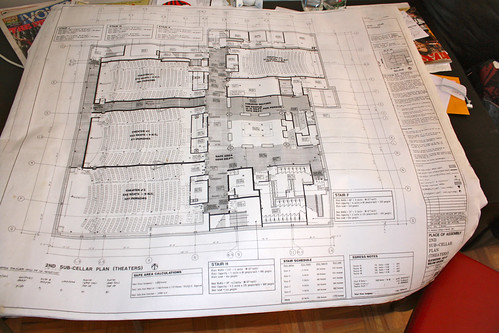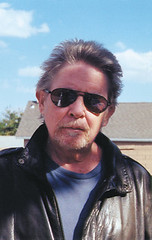 Stephen Rex Brown Blueprints for the CBGB in Times Square.
Stephen Rex Brown Blueprints for the CBGB in Times Square.Some punk rock purists might roll their eyes at Tuesday’s announcement that the CBGB Festival will hold a “multi-stage” concert in hyper-commercialized Times Square. But before you go cracking a Disney-meets-Dead-Boys joke, consider this: a few years before the legendary club on the Bowery closed, founder Hilly Kristal was on the verge of reopening it in Times Square.
The new location wouldn’t have been a mere recreation of the club that fostered the likes of The Talking Heads, Television, Blondie and many others, either. Mr. Kristal planned to drastically expand it. Blueprints drawn up of 1540 Broadway, which are pictured above, hint at the scale of his ambition.
He aimed to demolish a four-screen movie theater next-door to the now-closed Virgin Megastore and make it a club. Given that the theaters could seat 1,626 people total, it is clear that Mr. Kristal was fine with CBGB — which by then had developed into the merchandising bonanza it is today — moving on from the dirty bathrooms, dingy bar and sorry speakers of the original location. Read more…
Photos: Lauren Carol Smith.
The old CBGB is ready for its close-up, and The Local was on hand as a section of the bar, the phone booth, a urinal, pieces of wall and founder Hilly Kristal’s desk hit the road yesterday for Savannah, Georgia, where they will be used in the upcoming CBGB movie.
The assorted items still have hints of the glory days at 315 Bowery. The beat-up old desk has a list taped to it of phone numbers for old staffers at the club that closed in 2006. The toilets are still filthy and showed no signs of scrubbing (a latrine and a urinal from the women’s room are shown in our slideshow). Most surfaces are covered in band stickers, and the cash register still has a cut-out image of Mr. Kristal alongside a photo of Shakira.
Yesterday it had all been packaged with care in storage near the Brooklyn Navy Yard and loaded into a moving van bound for south of the Mason-Dixon Line. Read more…
 Godlis A 1977 photo of CBGB, which operated on the Bowery from 1973 to 2006. Owners of the club’s assets are now planning a festival and seeking to revive it at a new site.
Godlis A 1977 photo of CBGB, which operated on the Bowery from 1973 to 2006. Owners of the club’s assets are now planning a festival and seeking to revive it at a new site. For the last six years the name CBGB has been little more than a logo on T-shirts for young people in the East Village. Now a group of investors has bought the assets of that famous punk-rock club, which closed in 2006, and plans to establish an ambitious music festival this summer, with an eye toward reopening the club at a new downtown location.
The new owners of the club’s assets — some with ties to the original Bowery establishment — say they hope that the festival will revive the wide-open artistic aesthetic associated with CBGB, which in its heyday served as an incubator for influential acts like Television, the Talking Heads, the Ramones, Blondie, Sonic Youth and Patti Smith. Read more…
 Nancy Naglin Joe Kane
Nancy Naglin Joe KaneA veteran of The New York Ace, High Times, The New York Daily News and many other publications, Joe Kane describes how he got his start at EVO.
When I first migrated to Manhattan from Queens in 1970, it was with dreams of becoming a working scribe, preferably writing Beat fiction (unfortunately, one of the few things I was born too late for) and/or covering film in some capacity. Instead, I landed a boring temp job typing at a downtown insurance firm. During this time, somewhat happier circumstances led me to Screw, where the magazine’s then-art directors, Larry Brill and Les Waldstein, were going halves with publisher Al Goldstein on a new spin-off tab titled Screw X, a satirical variation on Screw (the height of redundancy, no?)
I auditioned for a writing/editing gig, with no guarantee Larry and Les would even get back to me. But a couple of days later, the phone rang in my East Sixth Street pad with promising news from the pair: Seems my work had been extolled by another of their writers, Dean Latimer, who told them it was “almost as good” (accent on almost) as his own stuff and that they should hire me straightaway.
For me, this was a frankly stunning turn of events. It so happened that Dean, whom I had never met, was already something of a personal hero; his “Decomposition” column and other writings were my favorite sections of The East Village Other. I considered Dean one of the most vivid and versatile writers I’d ever read anywhere, one equally adept at reportage, “think pieces,” memoir, criticism and totally devastating satire. That he had encouraging words for my fledgling efforts cheered me no end, and I resolved to thank my benefactor for his unsolicited largesse. Read more…







